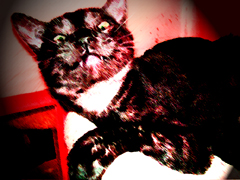The Weather Underground thingamajig in the top right corner reads 88 degrees Farenheit as I’m about to post this. How appropriate.
Please be sure to comment below, and let us know what you think..!
This past week, I decided to check out three foreign Westerns, the third of which I’d already seen a while ago, to add some balance perhaps: “the good, the bad, the weird” from South Korea (2008), “Renegade” from France (2004) and “800 bullets” from Spain (2002). All three are over two hours long.
There was one revelation: “the good, the bad, the weird”… It’s especially rare to laugh out loud as I did watching this, and to hit the back button on the DVD player to replay a scene.
I enjoy bathroom humor. I do. It was funny when I was a kid, it’s still funny now. One example is when the weird, Tae Goo, kills two men in the same way, by use of a rod kicked up their nether region with farting sounds and a weird expression of… Delight on one baddy’s face.
Yeah, I cringed too, but seeing as this was in a fight, not some torture scene, fair is fair.
But it’s not all off color jokes. Matter of fact it’s not all jokes, there’s quite a lot of bloodshed, shootings, stabbings et al. There is some excellent stunt work as well, horsemanship and gorgeous scenery which they shot mostly in Manchuria, in the desert.
There are three main characters, a bounty hunter named Do-Wan (the good), a ruthless psychopathic gun for hire going into business for himself named Chang-Yi (the bad), a train-robber with more lives than a cat named Tae-Goo (yes, the weird), and some strong supporting turns throughout.
During a train robbery, Tae-Goo (the weird), “acquires” what appears to be an invaluable treasure map, and from then on, he has both Do-Wan (the bounty hunter) and Chang-Yi (the killer) on his heels, as well as the Ghost Market Gang, Manchurian bandits, the Japanese and Manchurian armies, plus a few spies.
I’m hoping for a sequel because this Tae-Goo has mucho comedic potential. The bounty hunter’s more two dimensional (he’s supposed to be a good guy, and as we’ll see with Renegade, that can be a problemo).
As to Chang-Yi the bad guy, interesting look, with a dark pinstripe suit and hair covering half his face, Manga-style.
And yet, it all works. Maybe because director Kim Ji Yoo keeps the action moving fast, maybe because the score, evocating Ennio Morricone and the Gypsy Kings at times, is rousing, especially when the story veers into Road Runner and Coyote territory on an epic scale, and it works very well indeed.
This movie gets 5 beans

“Renegade”, the French Western, also uses an ancient map/manuscript as a ploy to bring villains in search of gold to the Sacred Mountains of the Chiracahua. Beyond that, “Renegade” becomes a convoluted mess.
The basis for this movie is a Belgian-French comic book which ran from the sixties to about the mid seventies, following the adventures of Mike “Blueberry” Donovan, a Southerner who joined the U.S. cavalry after the Civil War, and has a much more interesting character arc. In this adaptation, Blueberry (Vincent Cassel) has been transformed into a kid from a relatively well-to-do Cajun family, sent West to an uncle’s ranch to “straighten” out some. This was meant to “explain” Cassel’s French accent, but is a pretty big deviation from the original, and a questionable one.
Young Blueberry is involved in a fight at a whorehouse with Wallace Blount (Michael Madsen). Blueberry and Blount survive, but the girl Blueberry spent the evening with gets a bullet in the head and burns in a fire. Wandering outside the town, a wounded Blueberry is rescued and nursed back to health by Chiracahua Indians. He remains with them for a few years until we flash forward to the present, which finds Blueberry as town marshal, still haunted by that fateful night years ago.
No. He hasn’t gotten over it.
Meanwhile, the local big rancher (Jeffrey Lewis) sends two “adventurers” into the mountains to find gold: Woodhead (an underutilized Djimon Hounsou) and “Prosit” Luckner (Eddie Izzard with a dodgy German accent). Prosit Luckner’s made deals of his own, with Wallace Blount, who is after something more than just Indian gold.
Now, a few reviewers have been turned off by a couple of scenes using special effects, first to depict Blueberry’s vision quest with the Chiracahua, and secondly to show Blueberry’s surreal spiritual fight against Blount after they both drink some potion in the Sacred Mountains’ treasure cave.
“Renegade” has a number of problems, not the least of which being that the good guy is just about as vapid as the bounty hunter of “the good, the bad, the weird”, only more so. That is really a waste of Cassel’s talent. This makes the villain, Wallace Blount, the real center of gravity of the story, even though Michael Madsen is doing the same schtick he’s been doing since “reservoir dogs”.
Juliette Lewis (Jeffrey Lewis’ daughter in real life) is miscast as the rancher’s daughter, saloon manager and Blueberry’s love interest.
Lewis’ persona is too modern, but then…
Then the film makers sinned.
They sinned by having her belt out “Danny Boy” in her saloon, very badly slaughtering the song. And “Danny Boy” is really not something you caricature if you don’t want your audience to groan in pain.
It gets worse. She sings a few bars of it again later on, trying to bring Blueberry back to the living. That-actually-hurt.
There is beautiful scenery. There are some very good actors. But in this “baguetti Western” as Izzard called it, their talents are mostly wasted and the better scenes are actually the special effects sequences, which drag on a tad too long, especially the second one. Pass.
If you are interested in surrealism in a Western, check out “dead man” with Johnny Depp or “El Topo” with Alejandro Jodorovsky instead.
This movie gets no beans

A movie about movies is how director Alex de la Iglesia described “800 bullets”. The story takes place in modern day Spain, where we have a family torn by tragedy, as well as the land-grabbing scheme familiar to Westerns. Julian Torralba (Sancho Gracia) is a movie stuntman decades past his best days working on American Westerns shot in Almeria. Some years ago, his son died performing a stunt on a Russian backed Western. Julian now spends his days performing with his troupe for the occasional car load of German tourists, eking out a living, getting drunk and reminding everyone of his glory days doing stunts for Clint Eastwood or George S. Scott (sic).
His daughter in law Laura (Carmen Maura) is an executive at a real estate development firm in Madrid, living with her 10 year old son Carlos (Luis Castro) and her mother in law Rocio (Terele Pavez).
During a family move, Carlos discovers photos of his late father and of his grandfather, Julian. Laura refuses to answer his questions, but Rocio tells him about Julian before swearing him to secrecy. She and Laura get along icily. It’s summer recess and Laura puts Carlos on the school bus taking him to a ski trip. Carlos instead hops in a cab and ends up in the desert of Almeria wearing mountain clothing, looking for Julian.
You wouldn’t know it from reading the above, but “800 bullets” is a clever and fun comedy. It is mostly the lively dialogue and interaction between the very flawed (read ‘human’) characters which make this highly enjoyable. This is one to watch in Spanish with subtitles.
Julian is not a nice man, either. When Laura decides to buy the Western village where he and his troupe live and perform to build an amusement park, he visits her in Madrid to change her mind, promising he’ll never see Carlos again, and that he would put his grandson on the bus back to Madrid himself if Carlos tried to visit him in the future.
Laura’s not having any of this and the firm’s plans go ahead, prompting Julian to lead an armed resistance with his troupe of misfits.
“800 bullets” reminds me of “I sell the dead” in that you sense the enthusiasm and love of movies throughout the entire film. It’s also typical of Alex de la Iglesia’s movies in the rich tapestry of characters: it’s not just leads and supporting actors, virtually all of them have good lines and are funny and a unique depiction of who they are.
Take the cab driver who takes Carlos to Almeria (he also played the perv neighbor dressed as Darth Vader in de la Iglesia’s “la comunidad”). Or the undertaker, who years ago was hired on a Spaghetti Western which folded because of rain: throughout the movie, he cusses in Italian. The only thing he ever got out of that deal…
This movie gets 4 beans

It’s good to sample foreign made Westerns, “the proposition” being a prime example. France has a couple more which are also derived from a comic books series: “Lucky Luke”. They are not yet available in region 1 (unless in Canada but probably without subtitles), but hey, let’s hope for the best.









